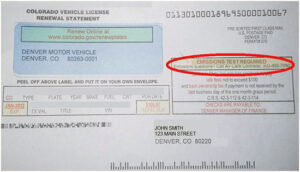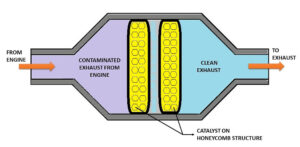Colorado began its emissions testing program in 1995 to keep the air we breathe everyday clean. Currently, the only vehicles that are exempt from testing are electric vehicles, kit cars, motorcycles, horseless carriages, vehicles registered as street rods or farm vehicles. Now that being said, any vehicle that is in it’s first 7 years after production will not need to be tested unless the title has been transferred to Colorado from another state, and similarly diesel engines are exempt from testing for the first 4 years unless the title has been transferred to Colorado from another state. Once you are out of that initial exemption period for new vehicles, gasoline engines will need to be tested every other year if the vehicle is 1982 or newer. For vehicles older than 1982 they will need to be emissions tested annually, unless registered as a collector’s vehicle which is subject to testing every 5 years. Additionally, any vehicle sold in the state of Colorado must pass emissions at the responsibility of the seller, therefore if you are selling your vehicle private party it is recommended you get the passing inspection receipt prior to listing the vehicle for sale.
Each year the DMV should send a postcard alerting you to when you are due for renewing your registration and on that postcard will have a section notating if an emissions inspection is due that year prior to renewal. Emissions testing for gasoline and hybrid vehicles can be performed at any Air Care Colorado testing facility around the state, and you can find the nearest location to you along with its current wait times here: https://aircarecolorado.com/locations/wait-times. It is recommended to go in the middle of the week, in the middle of the month and after 5pm on Saturdays to minimize your wait times. When visiting an Air Care Colorado facility for your emissions test you will not need to bring any paperwork or documentation, just the vehicle. Air Care Colorado also sets up “Rapid Screen” stations all around the state at highway entrances and exits that monitors your vehicle as you drive by to help identify exceptionally clean vehicles so that you don’t have to wait in line for testing the month your registration is due. In order to qualify for the Rapid Screen approval in leu of in person testing you must have two clean readings, one 14 months prior to your registration month, and one within 60 days. You can find where the Rapid Screen locations are set up this week here: https://aircarecolorado.com/locations/van-l/?tab=jl_magic_tabs_m_th_july_11_14th_gix1.

When you bring your vehicle in for an emissions test, they will first perform a brief visual inspection to establish that your vehicle is safe to test by ensuring there is not extreme fluid leaks, over-worn tires, etc. This test is not to be confused with a road safety test that many other states require, as Colorado only requires a passing emissions test to register your vehicle. If you fail the “safe to test” portion of the inspection you will receive an unable to test form, which is not an emissions failure. After you pass the safe to test inspection, they will then look over your vehicle to ensure all emissions systems components are present such as your catalytic converter and oxygen sensors, as well as verify there are no warning lights on the dash. Once that inspection passes, they will pressure test your gas cap to ensure it has an adequate seal that does not allow harmful emissions gases to escape through the gas cap. It is recommended to always have an OEM gas cap on your vehicle, as many aftermarket options fail the pressure test even if it is a brand-new gas cap. After your vehicle passes the gas cap test, they check see if the vehicle is visibly smoking which would be considered an automatic failure, but assuming your vehicle is not smoking they will plug in an OBD-II reader for all vehicles newer than 1996 to ensure all emissions monitors have run and are not setting any faults. Once your vehicle passes the OBD-II tests they may run your vehicle on the dynometer that is like a treadmill for your vehicle that monitors the number of hydrocarbons, carbon monoxide, carbon dioxide and nitrogen oxides molecules emitted through the tailpipe. The limit for hydrocarbons (HC) is 2 parts per million molecules, the limit for carbon monoxide (CO) is 20 parts per million and lastly, the limit for nitrogen oxides (NOx) is 4 parts per million molecules. Carbon dioxide (CO2) is not limited to any restrictions on parts per million as it is not a harmful gas. The reason why CO2 is still monitored is that if you fail for any reason, your technician can utilize this data as a diagnostic tool. CO2 is an indicator of a complete combustion, and the higher the reading the higher efficiency in a clean burn. One cylinder misfire in a 4 cylinder vehicle can decrease your ideal range by up to 25%.
The most common reasons why you can fail for too high of hydrocarbons is improper ignition timing, defective ignition components, the vehicle running too lean, or a defective catalytic converter. To get a proper clean burn your vehicle needs the right ratio of air to fuel partnered with the spark plug igniting this mixture at the right time for proper and clean combustion. If the timing is advanced then the spark plug is igniting this mixture too early causing excessive heat in the engine and a lean condition misfire, which then in turn causes an excessive buildup of hydrocarbons in the exhaust. The other common reason to fail for too high of HC is a failing catalytic converter which is a portion of the exhaust system filled with a honeycomb structure of many precious metals that at high temperatures will have a chemical reaction with the emissions gases and neutralize these gases. Catalytic converters are not designed to survive the lifetime of the vehicle and are considered a wearable part. However, by keeping your engine burning as clean as possible and maintaining regular vehicle maintenance prior to the point of failure you can help prolong your catalytic converter’s lifespan.
If you failed your emissions test due to the carbon monoxide exceeding maximum limits that typically means your vehicle is running rich. Meaning the vehicle is using more fuel than needed likely due to a faulty oxygen sensor, MAP (manifold absolute pressure) sensor, MAF (mass air flow) sensor, defective throttle position sensor, or defective engine coolant temperature sensor. The oxygen sensors in your vehicle are responsible for reporting to the ECM (engine control module) the oxygen content in the exhaust stream after it has left the combustion chambers as well as after it leaves the catalytic converter. Based on the data those sensors provide to the ECM will adjust the amount of fuel delivered, often providing more fuel than necessary causing the rich condition. A manifold absolute pressure sensor is responsible for monitoring and reporting to the ECM the amount of vacuum created during an engine’s intake stroke, if the manifold absolute pressure sensor determines there is a low amount of vacuum it assumes the engine’s throttle is open, meaning more air is going into the intake and therefore the ECM sends the command to the fuel injectors to increase the amount of fuel getting delivered. When a manifold absolute pressure sensor fails there is no longer the right air/fuel ratio and may in turn create a rich condition. A throttle position sensor communicates to the ECM what position the air intake’s throttle plate is in, which is typically controlled by a cable connected to the gas pedal. In some of the newer vehicles it is electronically controlled. When the throttle position sensor is faulty it communicates the wrong positioning to the ECM and the vehicle thinks it receiving more or less air than it truly is, and when in doubt the ECM always sends more fuel rather than less to avoid creating a lean condition that results in higher engine temperatures. Lastly, the engine coolant temperature sensor is responsible for communicating the engine’s temperature, and when a vehicle is cold the ECM commands for more fuel to compensate for a denser and more oxygen rich air to still maintain a clean combustion.
If you failed emissions testing due to high NOx it’s likely due to your vehicle running lean, a defective EGR system, defective catalytic converter, excessive carbon build up in the engine, or the vehicle is overheating. A lean condition happens when there is more air than necessary in the combustion chamber causing a very hot burn which in turn results in high NOx. A lean condition is frequently caused by vacuum leaks allowing more air in than what is monitored or defective fuel components causing improper fuel flow to the combustion chamber. A defective EGR system could also cause high NOx as it is designed to reduce NOx by rerouting some of the exhaust gases back to the intake manifold to get recycled in the combustion chamber as an inert gas to help stabilize combustion chamber temperatures. Some manufacturers have designed their vehicles to operate without an EGR system and those vehicles will tend to fail the NOx portion of the emissions test most likely due to a failing catalytic converter, but all vehicles are susceptible for failing NOx on account of the catalytic converter. Assuming all components related to the emissions system is operating as designed, you are likely failing for NOx due to excessive carbon build-up or your vehicle overheating. Excessive carbon build up happens over time, and typically the more miles you have on your vehicle the more carbon there is on the pistons, cylinder heads and valves. When there is excessive carbon build up it decreases the available space for the air/fuel mixture to combust therefore resulting in higher cylinder compression which leads to higher temperatures and therefore higher NOx like discussed above.

Trying to determine the source of your failing emissions test without any other symptoms can often prove very difficult and can quickly become costly if not diagnosed accurately from the start. Save yourself the headache and make an appointment at Seyfer Automotive if you received a failed emissions test to get your vehicle passing in no time! Seyfer Automotive is recognized on the Air Care Colorado site as a preferred repair facility for Wheat Ridge, Arvada, Lakewood, Littleton, Evergreen, and surrounding Denver-metro neighborhoods.
At Seyfer Automotive we strive to provide our customers the best service and treat you like one of our own friends and family. We promise to never recommend a service for your vehicle that we would not recommend performing on one of our own personal vehicles, and whenever possible alert you for upcoming maintenance so you never get a surprise repair bill. If you have any questions on how to best maintain your vehicle or schedule your next oil change or repair, call one of Denver’s longest standing Auto Repair Shop’s today! (303) 422-5261.

